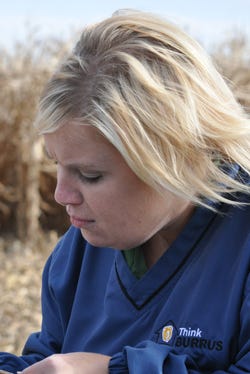
What’s your scouting plan for this season? Better question: Do you have a plan?
“The most common scouting mistake is not doing it at all,” says Angie Peltier, University of Illinois Extension educator. Digging roots. Collecting soil samples. Scrutinizing leaf or root damage. There’s no question scouting takes time.
Agronomists argue that in-season scouting efforts will be a lot easier, and clearer, than trying to look back in time to diagnose issues at harvest. Stephanie Porter, Burrus Seed, says after plants senesce, or naturally deteriorate, it becomes an educated guessing game as to what caused late-season issues like root lodging or yield loss.
Peltier and Porter share eight ways to scout like a pro this season:
1. Hop out of the truck. “Window scouting isn’t scouting,” Porter says. While some problems may be visible on end rows, you have to get out and scout at least five areas within each field, Peltier notes. Why? Disease and insect pressure tend to be higher on the end rows. “You don’t want to over or underestimate a problem that may or may not exist across the entire field,” she explains.

SLOW YOUR ROLL. “You can’t scout at 55 miles per hour,” says Angie Peltier, University of Illinois Extension educator. Peltier recommends checking at least five different areas in every field.
2. Keep checking. “I like to think of scouting as a season-long commitment,” Peltier says. From checking soil temperatures before planting to taking yield estimates, pinching stalks and prioritizing harvest timing, Peltier says there is something to track all season long.
3. Get social. Porter uses social media to tract trends, such as black cutworm feeding dates from Kelly Estes (on twitter: @ILPestSurvey). Estes throws a caution flag during cutworm moth flights and offers projected black cutworm feeding dates based on growing degree days. How do you spot damage? Click here for black cutworm specific scouting tips.
4. Use all available resources. Speaking of black cutworm, do the hybrids you planted have adequate early-season protection? Peltier uses this Handy Bt Trait Table that outlines trait packages and the protection they provide. Your iPhone is another useful tool, she adds, for referencing the Corn Foliar Disease Guide or the Crop Protection Network site, which includes the latest information on a new disease, Bacterial Leaf Streak.
5. Stay on top of new problems. New challenges can pop up above or below the ground, Porter notes, or old adversaries find a way to overcome treatment methods. Pythium root rot is back in the spotlight after 40 years of continued metalaxyl fungicide seed treatment use. Some pythium species are now considered “not sensitive” or are tolerant to metalaxyl fungicide, which created root rot issues in southeast Iowa and northeast Missouri in the last few years. Porter warns it’s something to watch for in Illinois.
Bacterial leaf streak, confirmed in 2016, can be easily mistaken for gray leaf spot or common rust, Peltier notes. Knowing the latest enemies lurking in fields is a smart way to avoid misidentification.
6. Start with problem fields. Every field should have boot tracks, but Porter starts with fields predisposed to tougher growing conditions such as continuous cornfields, no-till fields or cover-crop fields where pests and diseases may linger.

WHAT NOT TO DO. Stephanie Porter, Burrus Seed, strongly encourages farmers to identify problems in-season, not at harvesttime. “It’s so much easier to tell when it’s green,” she says.
7. Don’t make assumptions. Is it an abiotic problem like sidewall compaction that’s causing poor stands, or is it a seed-borne disease? “You have to rule out abiotic issues before you assume anything,” Porter explains. Dig up seedlings or roots, take soil samples, and do whatever it takes to determine the real issue.
8. Bring the right tools and equipment. Peltier carries a pen and paper for notes, a shovel for root digs, a hand lens to examine leaves and a cooler for plant samples. Plants heading to the University of Illinois plant clinic for further examination should be kept out of the sun. Protect yourself against the sun and Mother Nature, too, with sunscreen, long-sleeves and gloves.
“Make a springtime commitment to scout,” Peltier says. “It will be time well spent.”
About the Author(s)
You May Also Like




